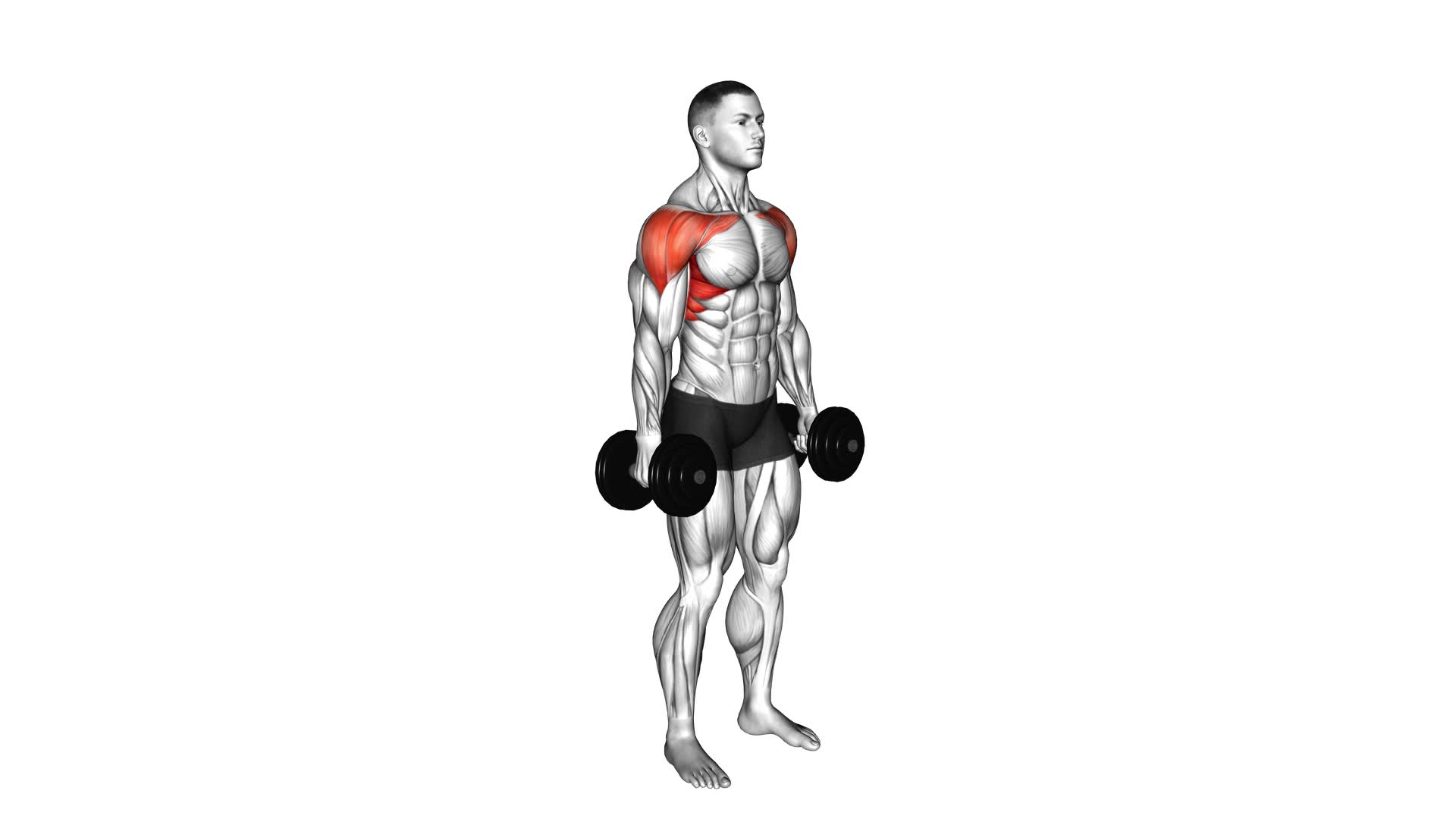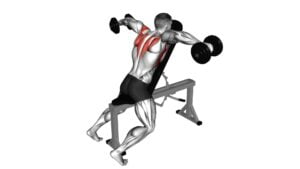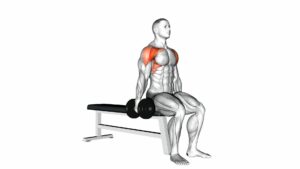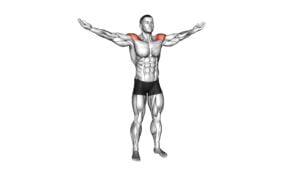Dumbbell Standing Alternate Vertical Front Raises – Video Exercise Guide & Tips

Looking to tone your shoulders and build upper body strength? Check out this video exercise guide for Dumbbell Standing Alternate Vertical Front Raises. In just a few minutes, you'll learn the proper form and technique for this effective exercise.
Watch This Exercise Video
Avoid common mistakes and maximize your results with helpful tips. Get ready to feel the burn and see the results with this targeted shoulder workout.
Let's get started!
Key Takeaways
- Dumbbell standing alternate front raises increase shoulder strength and stability.
- Proper form and technique include standing with feet shoulder-width apart, holding dumbbells with palms facing thighs, and avoiding swinging or using momentum.
- Variations and modifications can be made by changing grip, adding resistance, combining with other exercises, and experimenting with different options.
- Common mistakes to avoid include using too much weight, swinging the arms, raising the arms too high, and leaning back or arching the lower back.
Benefits of Dumbbell Standing Alternate Front Raises
You will experience increased shoulder strength and stability by incorporating dumbbell standing alternate front raises into your workout routine. One of the key benefits of this exercise is that it specifically targets your anterior deltoids, which are the muscles at the front of your shoulders. By strengthening these muscles, you can improve your overall shoulder stability and reduce your risk of injury.
The technique for performing dumbbell standing alternate front raises is relatively simple. Start by standing with your feet shoulder-width apart and holding a dumbbell in each hand, palms facing your thighs. Keeping your core engaged and your back straight, slowly lift one dumbbell up in front of you until your arm is parallel to the floor. Lower the dumbbell back down and repeat with the other arm. Make sure to keep your movements controlled and avoid swinging the weights.
Proper Form and Technique for Dumbbell Standing Alternate Front Raises
To ensure proper form and technique for dumbbell standing alternate front raises, it's important to focus on maintaining control and stability throughout the exercise.
Start by standing with your feet shoulder-width apart and holding a dumbbell in each hand, palms facing your thighs. Keep your core tight and your back straight.
As you lift one dumbbell in front of you, make sure to keep your arm straight but not locked and avoid swinging or using momentum to lift the weight. Control the movement as you raise the dumbbell to shoulder height, keeping your wrist straight and your shoulder blades pulled back and down.
Pause for a moment at the top of the movement, then slowly lower the dumbbell back to the starting position.
Alternate arms and repeat the exercise for the desired number of repetitions. Remember to breathe throughout the exercise and focus on maintaining proper form and control.
Variations and Modifications for Dumbbell Standing Alternate Front Raises
Explore different variations and modifications to enhance your dumbbell standing alternate front raises. Here are some options to consider:
- Change grip: Try using different grips, such as a pronated grip (palms facing down) or a supinated grip (palms facing up), to target different muscles in your shoulders and arms.
- Add resistance: Increase the challenge by using heavier dumbbells or adding resistance bands to your front raises. This can help build strength and muscle definition.
- Combine with other exercises: Incorporate front raises into a full-body workout by combining them with other exercises like lunges or squats. This can help engage multiple muscle groups and add variety to your routine.
By incorporating these variations and modifications, you can keep your dumbbell standing alternate front raises fresh and challenging.
Remember to always maintain proper form and listen to your body to prevent injury. Experiment with different options to find what works best for you and your fitness goals.
Whether you're a beginner or an experienced lifter, these variations can help you continue progressing and reaching new levels of strength and fitness.
Common Mistakes to Avoid During Dumbbell Standing Alternate Front Raises
What are some common mistakes to avoid during dumbbell standing alternate front raises?
Proper technique is crucial when performing this exercise to prevent injury and maximize the benefits. One common mistake is using too much weight. It's important to choose a weight that allows you to maintain proper form throughout the movement. Using excessive weight can lead to improper alignment and strain on the shoulders and neck.
Another mistake to avoid is swinging the arms. This not only reduces the effectiveness of the exercise but also puts unnecessary strain on the muscles and joints. Instead, focus on controlled movements, lifting the dumbbell in a slow and controlled manner.
Another mistake is raising the arms too high. The goal of the exercise is to bring the dumbbell to shoulder level, not above it. Raising the arms too high can lead to shoulder impingement and discomfort.
Lastly, avoid leaning back or arching the lower back during the exercise. This can put pressure on the spine and compromise the stability of the exercise. Keep the core engaged and maintain a neutral spine throughout the movement.
Tips for Maximizing the Effectiveness of Dumbbell Standing Alternate Front Raises
To maximize the effectiveness of dumbbell standing alternate front raises, focus on proper form and incorporating these tips into your routine:
- Keep your core engaged throughout the exercise to maintain stability and prevent swaying or arching of the back.
- Control the movement by using a slow and controlled tempo. Avoid swinging or using momentum to lift the dumbbell.
- Alternate the sides after each repetition to ensure balanced development of the shoulder muscles.
By following these tips, you can maximize the results of your dumbbell standing alternate front raises. Proper form and control are key to targeting the shoulder muscles effectively and avoiding injury. Remember to engage your core to stabilize your body and maintain proper alignment. Slowing down the movement will increase the time under tension, resulting in greater muscle activation and growth. Lastly, alternating sides will ensure that both shoulders receive equal attention and development.
While dumbbell standing alternate front raises are an effective exercise for targeting the front deltoids, there are alternative exercises you can incorporate into your routine for variety and to work different muscles. Some alternatives include bent-over lateral raises, seated military presses, or cable front raises. By incorporating these alternative exercises, you can further challenge your shoulder muscles and continue to see progress in your strength and muscle development.
Frequently Asked Questions
How Many Sets and Repetitions Should I Do for Dumbbell Standing Alternate Front Raises?
For dumbbell standing alternate front raises, it's important to consider the number of sets and repetitions that will work best for you.
The ideal number of sets and reps can vary depending on your fitness level and goals.
Generally, starting with 2-3 sets of 10-15 reps is a good place to begin.
However, it's always recommended to consult with a fitness professional or trainer to determine the best approach for your specific needs and abilities.
Can I Use a Barbell Instead of Dumbbells for This Exercise?
Yes, you can use a barbell instead of dumbbells for this exercise. However, using dumbbells has its benefits.
Dumbbells allow for a greater range of motion and engage stabilizing muscles more effectively. They also provide a more balanced workout for each arm, as they can be used individually.
Additionally, dumbbells allow for easier progression by adding or reducing weight incrementally.
Are There Any Specific Breathing Techniques I Should Follow While Performing Dumbbell Standing Alternate Front Raises?
When performing dumbbell standing alternate front raises, it's important to pay attention to your breathing technique. By exhaling as you lift the dumbbell and inhaling as you lower it, you can engage your core and stabilize your body during the exercise.
This controlled breathing pattern helps to maintain proper form and maximize the benefits of incorporating dumbbell standing alternate front raises into your workout routine.
Can I Incorporate This Exercise Into a Full-Body Workout Routine?
Yes, you can definitely incorporate dumbbell standing alternate front raises into a full-body workout routine. Doing so can provide several benefits, such as targeting your shoulders, upper back, and arms.
It also helps improve shoulder stability and posture.
To modify or vary this exercise in your routine, you can adjust the weight of the dumbbells, increase the number of repetitions, or combine it with other exercises like squats or lunges for a more challenging workout.
What Are Some Alternative Exercises That Target the Same Muscle Groups as Dumbbell Standing Alternate Front Raises?
Looking for alternative exercises to target the same muscle groups as dumbbell standing alternate front raises?
There are a few options you can consider.
One alternative exercise is the overhead press, which targets your shoulder muscles.
Another option is the bent-over lateral raise, which works your deltoids.
You can also try the Arnold press, a variation of the overhead press that engages multiple muscle groups.
Incorporating dumbbell standing alternate front raises into your full body workout routine can help strengthen and tone your shoulders and upper body.
Conclusion
To conclude, dumbbell standing alternate front raises are a highly effective exercise for targeting and strengthening the shoulder muscles. By maintaining proper form and technique, you can maximize the benefits of this exercise.
Additionally, incorporating variations and modifications can add variety to your workouts and prevent plateaus. Avoiding common mistakes and following the provided tips will ensure the exercise is performed correctly and safely.
Incorporating dumbbell standing alternate front raises into your fitness routine can lead to improved shoulder strength and overall upper body development.

Author
Years ago, the spark of my life’s passion ignited in my mind the moment I stepped into the local gym for the first time. The inaugural bead of perspiration, the initial endeavor, the very first surge of endorphins, and a sense of pride that washed over me post-workout marked the beginning of my deep-seated interest in strength sports, fitness, and sports nutrition. This very curiosity blossomed rapidly into a profound fascination, propelling me to earn a Master’s degree in Physical Education from the Academy of Physical Education in Krakow, followed by a Sports Manager diploma from the Jagiellonian University. My journey of growth led me to gain more specialized qualifications, such as being a certified personal trainer with a focus on sports dietetics, a lifeguard, and an instructor for wellness and corrective gymnastics. Theoretical knowledge paired seamlessly with practical experience, reinforcing my belief that the transformation of individuals under my guidance was also a reflection of my personal growth. This belief holds true even today. Each day, I strive to push the boundaries and explore new realms. These realms gently elevate me to greater heights. The unique combination of passion for my field and the continuous quest for growth fuels my drive to break new ground.







